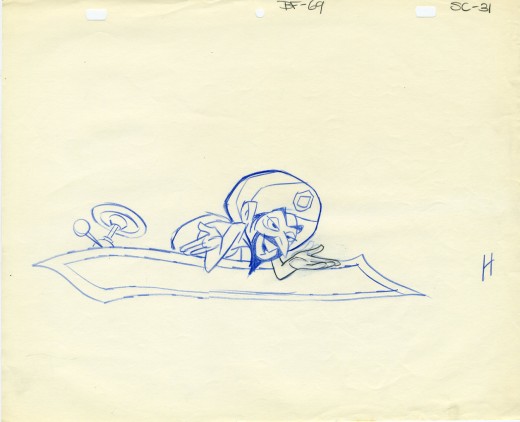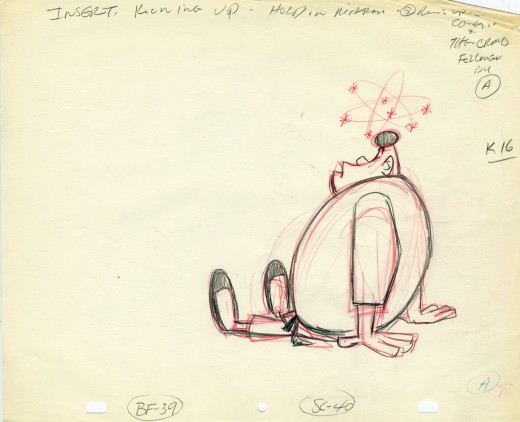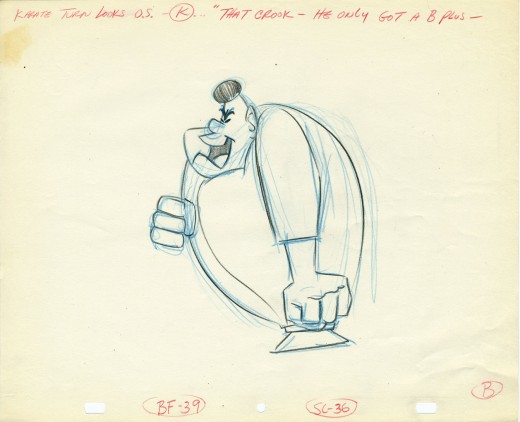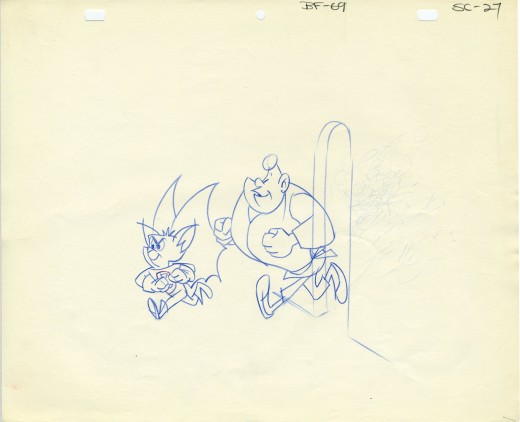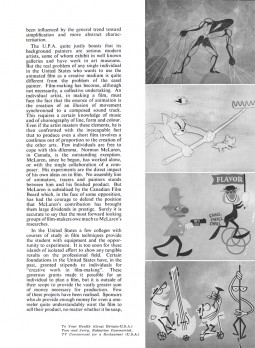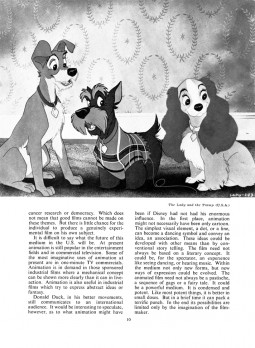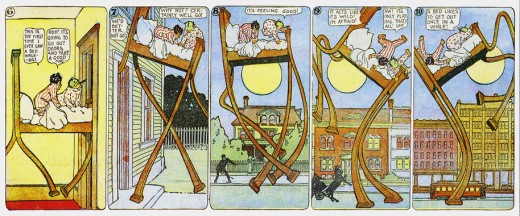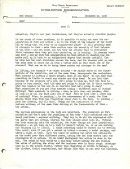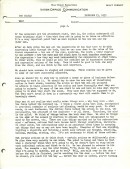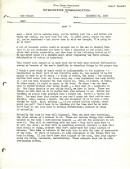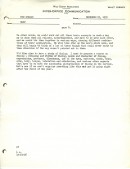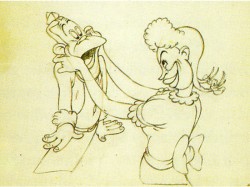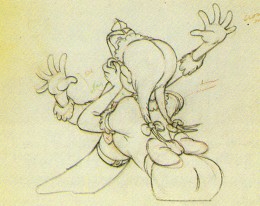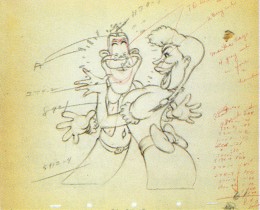Category ArchiveAnimation Artifacts
Animation Artifacts &Books 14 Aug 2006 06:42 am
Turney 2
Here are a couple of provocative articles about animation:
- The Cartoon Conundrum. A NYPost article about the marketability (or not) of star voices in animated films. here
- A British article about the rise of “Adult” themed animated features. here
The Turney Book
- Continuing yesterday’s post, there are a number of photographs in Harold Turney’s “Filmguide’s Handbook to Cartoon Production. 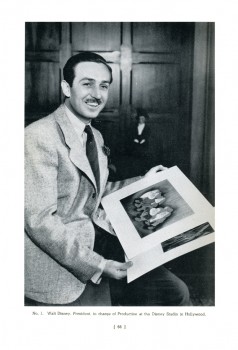 Many of the photographs are unique to this volume, and I wasn’t able to scan more of them yesterday.
Many of the photographs are unique to this volume, and I wasn’t able to scan more of them yesterday.
It’s an odd little book, held together with two staples. However any publication on the animation process was a rarity in 1940. Aside from the Lutz book and Nat Falk’s book on Terrytoons, there’s little more.
The book includes this dedication: “Cartoon Production” is herewith dedicated to all teachers, club group leaders, and librarians as an enduring aid in answering the oft-repeated question, “How are cartoons made?” – H.T.
I don’t know where the book was sold, though I do know that many of the people in the studio were given a copy. It seems to have been part of a subscription offering. I find it a bit odd that you don’t see many copies of it around. This is the only copy I’ve ever seen.
I’ll post more of the photos tomorrow.
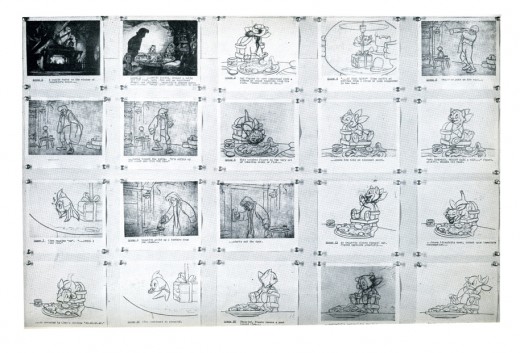 (Click on any of the images to enlarge.)
(Click on any of the images to enlarge.)
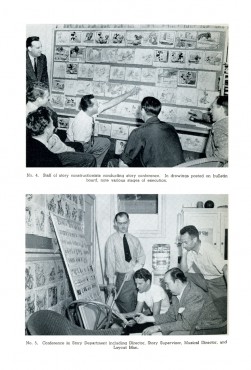
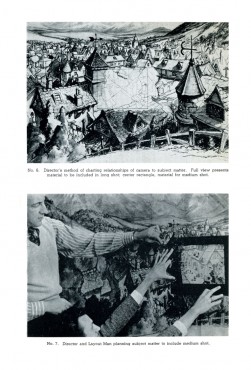
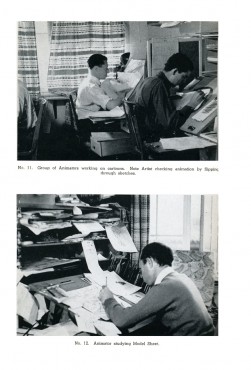
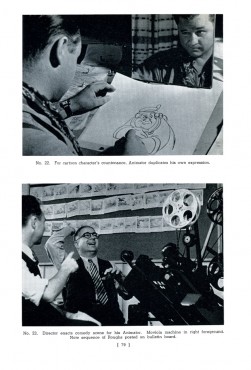 Just above, the photo on the upper left shows two animators. I believe the animator on the right is Norm Ferguson. I’m not sure who any of the others are though I would guess the director at the movieola in the photo on the lower right is Jack Cutting, director of The Ugly Duckling (the pictures behind them), who appears in yesterday’s post.
Just above, the photo on the upper left shows two animators. I believe the animator on the right is Norm Ferguson. I’m not sure who any of the others are though I would guess the director at the movieola in the photo on the lower right is Jack Cutting, director of The Ugly Duckling (the pictures behind them), who appears in yesterday’s post.
If anyone out there can identify any other of these artists, please leave a comment.
Animation Artifacts &Books 13 Aug 2006 08:43 am
Treasures
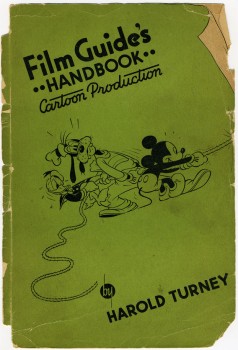 – This Harold Turney “Filmguide’s Handbook to Cartoon Production” is one of the things I treasure in my little collection.
– This Harold Turney “Filmguide’s Handbook to Cartoon Production” is one of the things I treasure in my little collection.
It was smallish book published in 1940. Apparently, there was a whole series of these books about film production. It has about 65 pages of print on heavy newsprint paper followed by about 20 pages of B&W photos on semi-gloss paper. Many of the photos printed there don’t seem to have appeared in many other places. (Though I’ve found one or two lately on the internet.)
The pictures are almost wholly those of Pinocchio’s production.
I’m posting a few of the pages. There are several to do with animators. The only picture posted here shows Fred Moore at his desk (cigarette in hand). The model maker below him is pictured with a marionette behind her. That marionette was merchandised; I have one. These were pre-plastic days. It’s made of some wood pulp product, very interesting to me. There’s also an odd studio photo of Disney manipulating the same marionette.
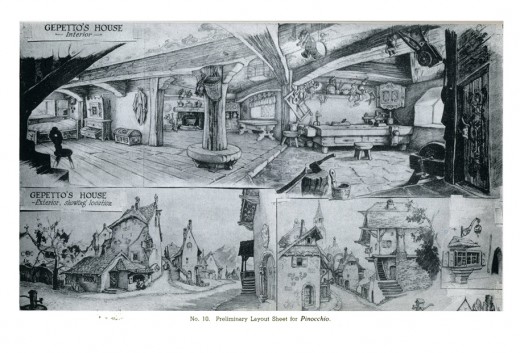
(Click on any image to enlarge.)
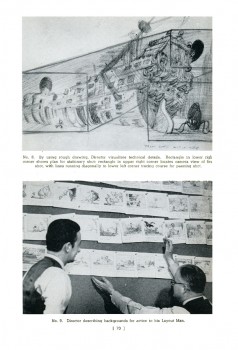
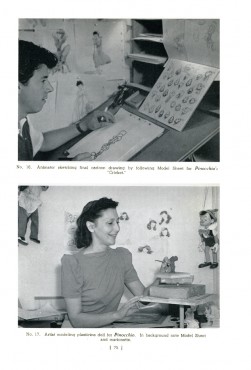
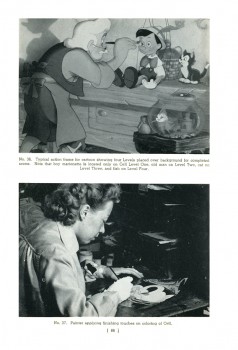
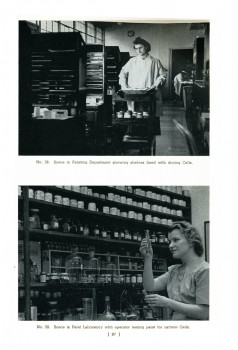
Animation Artifacts 02 Aug 2006 08:22 am
Lincoln Center Disney
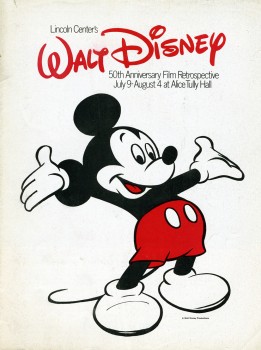 – Way back in 1973, Walt Disney Studios teamed up with Lincoln Center to present a complete retrospective of their work, celebrating the fiftieth anniversary of Disney.
– Way back in 1973, Walt Disney Studios teamed up with Lincoln Center to present a complete retrospective of their work, celebrating the fiftieth anniversary of Disney.
This was a big deal for animation buffs in New York. Aside from presenting all the Disney features, live action as well as animation, they presented many of the shorts in special programs. (This was long before videos were available – even before Beta.) There were also a number of seminars with Frank Thomas, Ollie Johnson, Woolie Reitherman, and Ken Anderson.
The tickets for the talks were sold in advance, but the seats weren’t reserved. We’d cue up outside the small, Lincoln Center Library theater hours in advance to get the better seats. This is where I first met a number of young students including: Tom Sito, Mark Mayerson, Lou Scarborough and Dan Haskett. Mind you, I wasn’t much older, but I was already working for the Hubleys, so I had some cache as a “professional.”
The talks were lively. I can remember the audience being critical of the “disco light” scene in The Aristocats, and Frank & Ollie pointing to Woolie saying it was his fault. None of them wanted it, but he thought they should stick it in “for the kids.” There were quite a few surprises, with plenty of clips and pencil tests. They were promoting Robin Hood, and the audience didn’t seem very enthusiastic – or maybe it was just me. If I remember right, I believe the film had already been released.
The Museum of Modern Art had some adjoining programs of shorts which I remember to this day. There was the program of silent shorts which ended with Steamboat Willie. Boy, did you get the effect of the first sound Mickey film. They presented the first color Disney short in the same way: a lot of B&W shorts followed by Flowers and Trees. Great programming.
It was a nice time to be in New York.
Here’s the schedule and an article by John Culhane from the program:
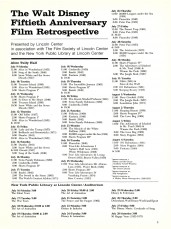
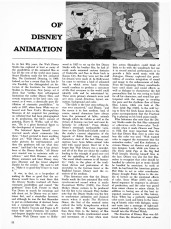
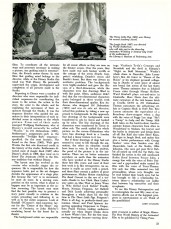
(click on any image to enlarge.)
Animation Artifacts &Daily post 31 Jul 2006 09:41 am
Building & Building
Hans Perk has posted the drafts to Building A Building on his site, A Film LA. It brought an immediate memory back to me.
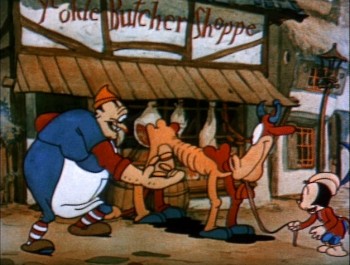 When I was 12 I got my first 8mm projector. This was before the days of dvd, before the days of vhs. I rigged the projector to project one frame at a time so I could study every frame of the films I was able to buy. Ub Iwerks’ film, Jack and the Beanstalk was probably the first of the films I watched this way. One frame at a time. As a matter of fact, I traced the characters off the projected screen. (Little did I realize it was Grim Natwick’s anima- tion that I was studying so ardently. He wasn’t enormously impressed, years later, when I mentioned this to him in an interview. Regardless, his influence on me was strong.)
When I was 12 I got my first 8mm projector. This was before the days of dvd, before the days of vhs. I rigged the projector to project one frame at a time so I could study every frame of the films I was able to buy. Ub Iwerks’ film, Jack and the Beanstalk was probably the first of the films I watched this way. One frame at a time. As a matter of fact, I traced the characters off the projected screen. (Little did I realize it was Grim Natwick’s anima- tion that I was studying so ardently. He wasn’t enormously impressed, years later, when I mentioned this to him in an interview. Regardless, his influence on me was strong.)
Building A Building was another of these I studied; it’s a film I loved the second I saw it – even in that silent world of 8mm.
There were a lot of films I went through, but only a few I treasured (the 8mm library wasn’t a great one.) I was a big Iwerks fan, and his films were accessible back then. Aladdin’s Lamp, Sinbad the Sailor, and a Willie Whopper film; What Makes Daffy Duck gave me a real appreciation for Art Davis’ direction; Little Lulu’s Bored of Education gave me Bill Tytla’s direction; a couple of Heckle & Jeckles offered the treat of Jim Tyer’s animation.
It was a bric-a-brac animation education, but it colored my thoughts. My early influences became Bill Tytla, Grim Natwick, Art Davis and Jim Tyer. A feast for someone in love with animation and the graphic arts.
- Today any kid can watch anything they want. It’s all available. After seeing Lady and the Tramp in 1955, I wasn’t able to see it again till 1962. The same is true of all of those Disney classics – every 7 years, and that was it. Unless there was a Disneyland TV special compiling clips.
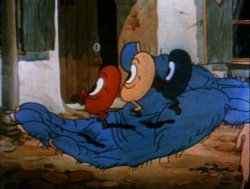 Today, any child can watch any of the features, then make frame grabs from the film. They can put a section up on YouTube if they want. It’s a whole new world, and there seems to be less to see, somehow. Is it all appreciated? Does any of it get to be special?
Today, any child can watch any of the features, then make frame grabs from the film. They can put a section up on YouTube if they want. It’s a whole new world, and there seems to be less to see, somehow. Is it all appreciated? Does any of it get to be special?
I wonder if in being forced fed that “specialness†, I was made to appreciate something in any greater way. Does a child, today, desperate to go into animation, have the same influences? Are they better and greater since the film choices are so much better? I’d love to know if the overabundance of seed thrown by the wayside is equal to the paltry few doled out. I guess it’s a question I can’t answer.
- 4 animated features are currently in theaters. Here are the box office receipts for the past weekend:
Monster House grossed $11,500,000 with an average daily per-theater take of $1079.
The Ant Bully grossed $8,145,000 with an average daily per-theater take of $890.
Cars grossed $2,467,000 with an average daily per-theater take of $1500.
A Scanner Darkly grossed $454,000 with an average daily per-theater take of $1726.
Next weekend Barnyard enters the fray. My favorite figure is for A Scanner Darkly which makes the highest per screen average. Maybe some intelligent entrepeneur can try an adult animated feature with an other technique rather than rotoscoping. Imagine Waking Life with a drawn, not rotoscoped, style. (It wouldn’t have worked with Scanner.)
Animation Artifacts 28 Jul 2006 07:32 am
Batfink
- I have a large number of layout drawings from some of the Batfink episodes. I have these listed as being drawn by Dave Tendlar, but I won’t guarantee that. Some of the drawings are good. I believe this episode was called “The Thief From Baghdad” done in 1967.
The layouts don’t give too many poses for any setup, however there weren’t too many poses in any of the films. So, they’re probably all here. Undoubtedly, this show would have been done in Flash had it been done today, and it probably would have suffered. Unfortunately, the quality wasn’t very good, so it really wouldn’t have mattered.
Years before the racism of Letterman‘s Spellbinder, this show went farther. Arab and Japanese stereotypes didn’t seem to matter back in the 60′s when political correctness didn’t exist.
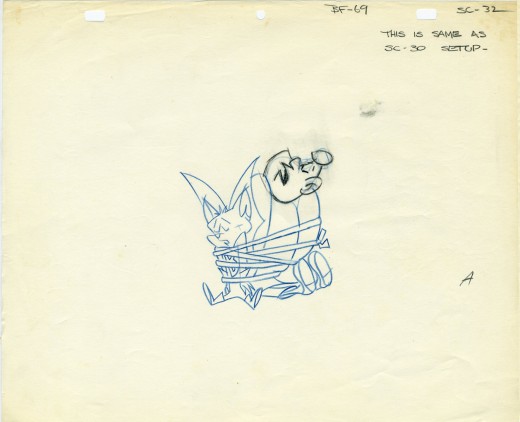
(Click on any image to enlarge.)
Animation Artifacts 25 Jul 2006 07:33 am
Philip Stapp Writes
I’d like to post another article from that same British Film Academy “Journal. ” on the International Animated Film. This was published in 1956.
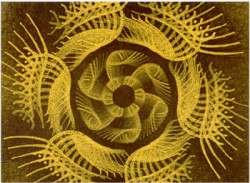 Philip Stapp writes a survey of animation in the United States. It’s an articulate article that I found worth reading. Stapp‘s view of the animation world is a bit high brow, as were many of the UPA supporters of the time. (It seems there were those that didn’t get UPA and those that got only UPA.)
Philip Stapp writes a survey of animation in the United States. It’s an articulate article that I found worth reading. Stapp‘s view of the animation world is a bit high brow, as were many of the UPA supporters of the time. (It seems there were those that didn’t get UPA and those that got only UPA.)
Stapp was an interesting, creative film maker. He has gained much of his fame for the educational films he did for Julien and Sam Bryan‘s International Film Foundation. This was one of the foremost and most diverse educational film producers which had a strong focus on international geography, history and relationships. Philip Stapp did quite a few films for them, and they show a strong sense of design as a way of clearly illustrating their information.
I initially came upon Stapp‘s name when I did one of my first films; it was also for Sam and Julien Bryan. I was treated like an artist and allowed to do whatever I wanted to do. My job was no more than an illustrated map (a long one), but I did a very complicated affair in trying to get a lot across. Sam Bryan lent me a number of Stapp‘s films to view, and I gobbled them up. I’d like to see more written about Philip Stapp in time. As a matter of fact, it’d be nice to see more written about Sam and Julien Bryan.
Here’s the article.
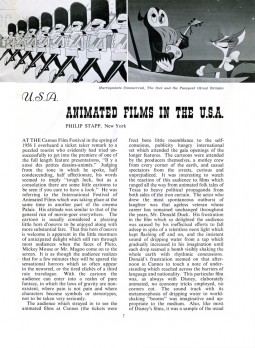 1
1 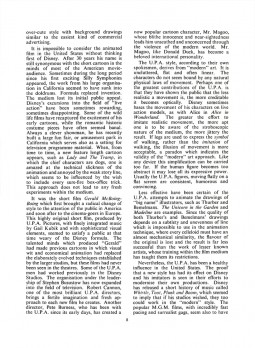 2
2
(Click on any image to enlarge.)
Animation Artifacts 23 Jul 2006 07:02 am
Jean Image article
- Just for amusement, I’m posting an article from the Journal of International Animated Film published by the British Film Academy in 1956. This, of course, was prior to the development of ASIFA and the development of animation festivals.
Within the magazine they’ve asked a number of animation producers to write articles about the state of animation.
The article posted here is by Jean Image, who was the preeminent producer in France at the time. He was producing a number of feature films at the time. This is called: What Future is there for the Animated Film?
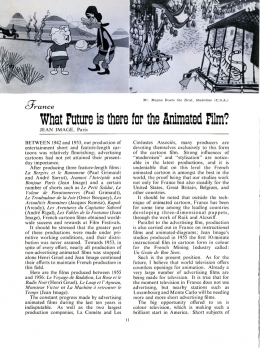
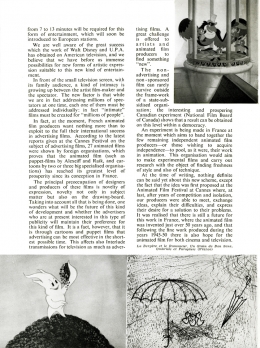
(Click either image to enlarge.)
Animation Artifacts 20 Jul 2006 07:38 am
Memo: Disney Classes
- Hans Perk, on his excellent site A-Film LA, has been posting many of the Disney notes for the afterhours classes at the studio in the 30′s. I also have a pretty complete collection of these. One document that I value is the original memo Walt Disney sent to Don Graham in 1936 discussing how they should set up these classes.
The letter gives a clear indication of what Disney thinks a good animator does, and what makes for a good animator.
Since Hans is taking a break and hasn’t posted this, I thought I would. It’s an interesting memo. Here are the 8 pages:
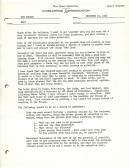 1
1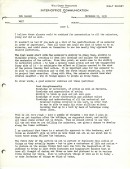 2
2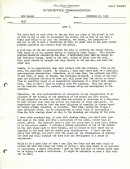 3
3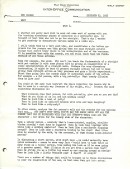 4
4
(Click any image to enlarge.)
- Alan Cook on his blog Cooked Art has an interesting commentary on CGI vs rotoscope vs motion capture. It’s worth the read, and his site is worth visiting.
- Dave Nethery on his site You’re A Gazelle features photos of a Cintiq imbedded in an animation table virtually replacing the disc. It’s an interesting idea on an interesting blog. His studio site is also worth a visit.
Animation Artifacts &Illustration 12 Jul 2006 07:32 am
Celebrity Caricature
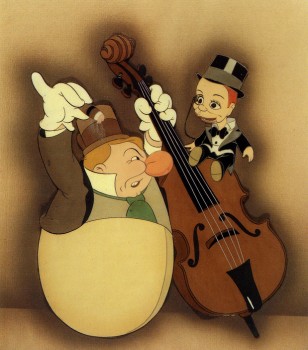 -I’m currently researching the art of Covarrubias. An exhibit at New York’s Public Library at 42nd Street in 1998 was one of the best I’ve ever seen. It was a program of “Celebrity Caricature” mostly from the 20′s & 30′s. Covarrubias, the developing Hirschfield, and a number of other brilliant artists were all represented well. In among the art was a small section on animated caricature. Drawings by Tee Hee and Joe Morgan were on display with a couple of cel set-ups. There were also a couple of WB model sheets (without artist names.)
-I’m currently researching the art of Covarrubias. An exhibit at New York’s Public Library at 42nd Street in 1998 was one of the best I’ve ever seen. It was a program of “Celebrity Caricature” mostly from the 20′s & 30′s. Covarrubias, the developing Hirschfield, and a number of other brilliant artists were all represented well. In among the art was a small section on animated caricature. Drawings by Tee Hee and Joe Morgan were on display with a couple of cel set-ups. There were also a couple of WB model sheets (without artist names.)
From the book of that exhibit I’m posting some of the animation art represented. Again no names are given.
(cel – Charlie McCarthy & W.C. Fields in “Mother Goose Goes Hollywood”)
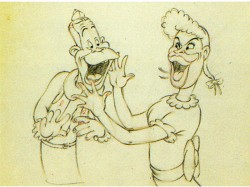
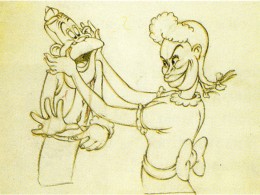
(Click on any image to enlarge)
(Joe E. Brown and Martha Raye from “Autograph Hound”)
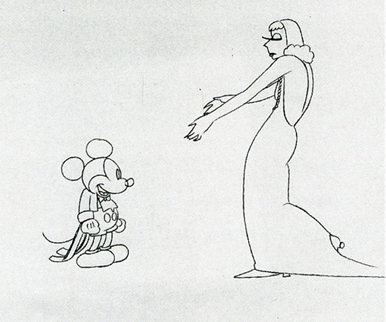
(Garbo & Mickey – animation drawing for Mickey’s Gala Premiere)
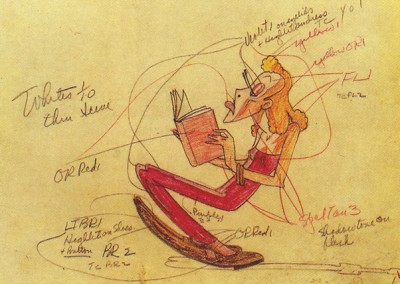
(Greta Garbo model sheet for Warner Bros.)
A small sampling of this show can be found on the National Portrait Gallery website. Non-animation caricatures are on view there, and the beautiful book/catalogue can be purchased there.
Credits for the above stills goes to:
1. “Mother Goose Goes Hollywood” from the collection of Jeff & Therese Lotman
2-5. “Autograph Hound” National Portrait Gallery, Wash.D.C.
6. “Mickey’s Gala Premiere” WDFeature Animation Research Library
7. The Steve Schneider Collection
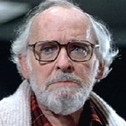
- Actor, Barnard Hughes died yesterday at age 90. I worked with him several times and found him hilariously subtle in his sense of humor. He was the perfect actor in a couple of my films. In What’s Under My Bed? he told a nightmarish story in my adaptation of James Stevenson‘s book. In The Emperor’s New Clothes, he was one of five narrators telling the tale. I’ll miss his talent. This is the NY Times obituary.
- In case Cartoon Brew‘s link to Jim Hill Media hasn’t enouraged you, let me give you the link to the Floyd Norman article there about life in the “Bullpen” at Disney in the ’50s. Floyd’s book, How The Grinch Stole Disney, is on sale at Afrokids, and I encourage you to look into it. The man has a real wit and it comes across well in all of his books.
Animation Artifacts 28 Jun 2006 07:32 am
Spunky & Tadpole
Spunky and Tadpole is a dark spot in my unconscious memory of bad animation that I 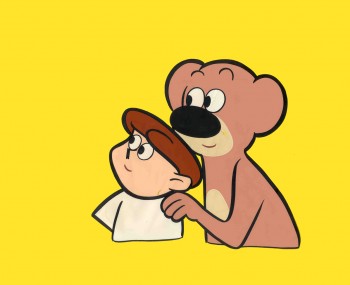
somehow have an affection for.
Jerry Beck listed it as one of the ten worst animated series ever created. (I don’t agree with that, certainly not with all those abominable Hanna-Barbera/Filmation/ Ruby-Spears shows that were so godawful and unwatchable. At least Spunky and Tadpole had a bit of style; perhaps because it stands out, it can be recognized as bad. It was bad; just not among the very worst. But I’m splitting hairs; bad is bad.)
There seems to be very little recorded about the production of the show. A couple of vhs copies of the series exists in the remainder bins of the internet and can be bought for little. The only credit listed anywhere on-line is that of a director, Art Moore, whoever he may be. I haven’t been able to locate any information about him either. (Someone on a chat room thinks he may be the producer of The Regis Philbin show.)
The show went into distribution via syndication in 1958 and was virtually knocked out of business by the rise and popularity of 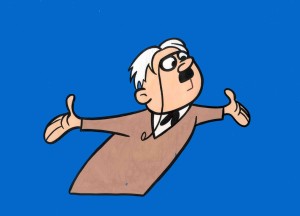 Hanna-Barbera’s product, Huckleberry Hound and Yogi Bear. Spunky & Tadpole were featured on local programs that had local hosts introducing shorts. I was surprised to find out that as many as 150 episodes of the serialized cartoon series were produced.
Hanna-Barbera’s product, Huckleberry Hound and Yogi Bear. Spunky & Tadpole were featured on local programs that had local hosts introducing shorts. I was surprised to find out that as many as 150 episodes of the serialized cartoon series were produced.
The cast included: Joan Gardner as Spunky, Don Messick as Tadpole. Ed Janis replaced Don Messick in the last episodes.
This cast means the show was probably done in LA.
(Click on images to enlarge and properly view the excellent inking.)
Some time ago, I still couldn’t resist buying a couple of cels which were selling on Ebay for just about nothing. They still amuse me.
- Speaking of good animation acting, Mark Mayerson has another chapter in his provocative series on Acting in Animation. I enjoy these posts; they get my mind working on a sore subject. (Sore subject because Bad Acting is pretty much all I see these days. Lots of jerking from pose to pose animation.)
